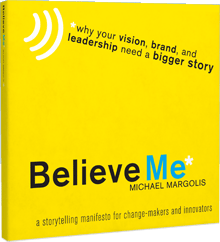As I noted in yesterday’s entry, I’m introducing Michael Margolis’s new book, Believe Me: Why Your Vision, Brand, and Leadership Need a Bigger Story by asking him some questions about it, as well as sharing my own impressions.
I asked Michael what kind of reaction the book has generated. Here’s what he said:
This book is intended to be a conversation starter. So I welcome correspondence from your readers. The feedback I hear regularly about the book, is that its short, provocative, and digestible. Honestly, I wrote it for someone like me who has a pretty dismal attention span. So the print is big, the layout is fun, and every few pages, something is designed to jump out and get you thinking. And yet somebody like me also expects substance, meaning, and emotional depth. That’s who I tried to write for. The book will probably leave you with more questions than answers. And that’s equally part of the intent. This book is not for everyone. It’s just 88-pages long (short enough to read on a plane, or in a single sitting). I was trying to write more in the style of Tom Peters or Seth Godin (two of my business book role models), yet make it something totally unique and unexpected in terms of narrative format/structure. I’d love to hear what your readers have to think. As you know they can download a free excerpt of the book, and that way get a better sense of the book’s message and visual experience.
The book centers on 15 storytelling axioms (my favorite: “Reinvention is the new storyline”), and the design most definitely is fun and easily digestible. In turn, the 15 axioms fall into one-word categories (for example, Meaning, Perception, Relationship, Memory, and Choices) within three “Acts.” These Acts, Michael says, follow the classic three-act story structure: Set-up, Confrontation, and Resolution (also known as beginning, middle, and end). A wonderfully useful section in the back of the book, Putting Ideas Into Practice, summarizes the one-word categories in the Acts by presenting prompts/questions to ask yourself “to explore your story.” For the “Meaning” category, for example, the prompts/questions are:
- What is most meaningful or memorable about your story?
- What kind of bigger experience might people pay a premium for?
Full-page quotes are liberally sprinkled throughout the text, and I plan to record these quotes in my Story Wisdom section.
Michael ends the book with a page titled, “This Story Is Just the Beginning,” in which he notes that Believe Me is just an introduction and tantalizes by promising to produce more practical followup books. In tomorrow’s entry, Michael talks more about the future books he has in store.
